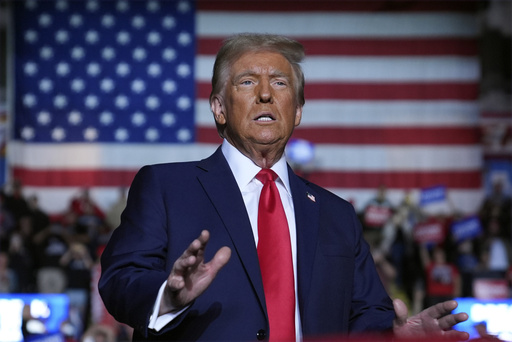
PITTSBURGH, Pa. — For nearly ten years, Donald Trump has consistently touted the size of the crowds at his rallies. However, as he embarks on his third presidential campaign, he finds himself facing a rival who also draws large audiences, highlighting the fact that his own events sometimes leave seats unfilled and attendees dwindling as he speaks.
This past weekend in North Carolina, Trump addressed supporters at the First Horizon Coliseum in Greensboro, a venue that accommodates 22,000 people. The lower level was noticeably sparse, with an upper level that was closed off entirely.
Despite this, he made the exaggerated claim, “We’ve had the biggest rallies in history of any country. Every rally’s full. You don’t have any seats that are empty.”
The day before the election, Trump began his campaign day in Raleigh, North Carolina, where although the crowd brought the venue close to capacity, there were still noticeable empty seats. Following this, he visited Santander Arena in Reading, Pennsylvania, which has a capacity of 7,200, only to find sections of the arena unoccupied. To mask this, his team hung a large American flag at the back of the arena to obscure the empty seats.
Trump then traveled to PPG Paints Arena in Pittsburgh, where again the upper seating section was blocked off to minimize visibility of unfilled seats.
Even though Trump continues to draw thousands of supporters who enthusiastically respond to him, his events this year starkly contrast with those of Democratic nominee Kamala Harris, whose recent rallies have been significant in size and energy compared to Trump’s earlier campaigns.
It’s worth noting that the size of crowds does not reliably indicate electoral success. Trump’s core base remains engaged, as demonstrated by his recent rally that successfully filled Madison Square Garden in primarily Democratic New York City. Nevertheless, during this campaign cycle, his audience sizes have generally been smaller compared to earlier races, especially during his initial run when his rallies became a notable aspect of political culture.
Recently, attendees at his events have been leaving in noticeable numbers, sometimes even during his extended two-hour speeches, despite having waited for hours to see him. Trump has reportedly been revisiting the same battleground states and venues, including a recent return to Greensboro just a week after his last visit there.
The reasons for the change in crowd sizes remain unclear, but it’s evident that Trump, a former reality TV star with a flair for performance, remains anxious as Harris matches and sometimes exceeds his rally attendance. For instance, she recently energized the crowd at a major event in Greensboro with a substantial turnout.
The dynamics of crowd sizes have not gone unnoticed by Democrats, who see it as an opportunity to unsettle Trump. Former President Barack Obama, who integrated mass rallies into his campaigns prior to Trump and Harris, humorously addressed Trump’s “weird obsession” with crowd numbers at the Democratic National Convention. He made jestful hand gestures that referenced Trump’s own comments about size that have previously implied broader personal connotations.
Harris also made references to the significance of crowd sizes during her debate against Trump, urging prospective attendees to gather at his rallies to recognize that his time in the spotlight may be fading.
On Monday night in Pittsburgh, Trump took shots at Beyoncé, who made an appearance at a recent Harris event that attracted over 30,000 attendees. Although the pop star didn’t perform, her presence highlighted the competitive nature of celebrity endorsements as Harris rounds out her campaign with notable figures like Oprah Winfrey and Lady Gaga at her final rally in Philadelphia.
Amidst the political festivities, Trump has recently displayed a nostalgic tone regarding the rallies. “I have one left,” he remarked in Pittsburgh, while contemplating an upcoming late-night event in Grand Rapids, Michigan. “And remember, the rallies are the most exciting thing. They’ll never be rallies like this. This is never going to happen again.”
